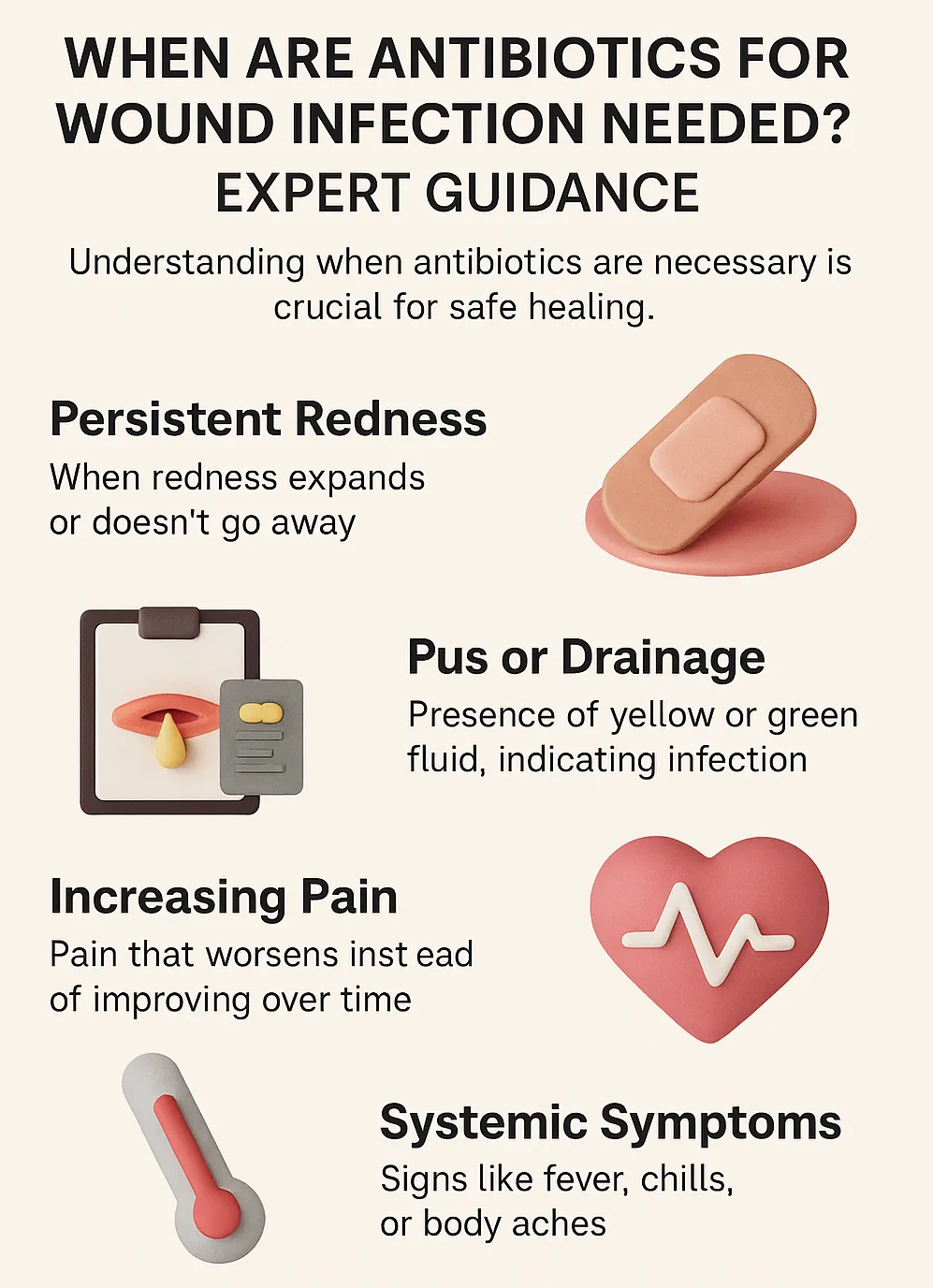If you’ve ever dealt with a cut or surgical wound that became red, swollen, or slow to heal, you may have asked: “When are antibiotics actually necessary for wound infection?” The answer isn’t always straightforward. Antibiotics can be life-saving in the right situations, but in others, careful wound care may be the safer and more effective path.
From my experience working with both everyday injuries and surgical patients, I’ve seen antibiotics reverse dangerous infections. I’ve also seen them prescribed when attentive cleaning and monitoring would have been enough. Knowing when antibiotics are truly required—and when they may cause more harm than good—is the key to safe recovery.
This article provides expert guidance on when antibiotics are needed, risks of overuse, and practical steps for faster healing.
Top Takeaways
- Antibiotics are most effective for serious cases. They help when infections spread or become systemic.
- Overuse carries risks. Misuse fuels antibiotic resistance and side effects.
- Wound care matters most. Prevention, cleaning, and monitoring often speed up healing.
- Consult a doctor. Only a medical professional can confirm when antibiotics are necessary.
When Antibiotics Become Essential
Antibiotics for wound infection can be highly effective, but they aren’t always the first step. In many mild cases, wound cleaning, dressing changes, and monitoring are enough. Doctors usually prescribe antibiotics when there are signs of spreading or deeper infection, such as:
- Expanding redness and warmth
- Increased swelling and tenderness
- Pus or significant drainage
- Fever or systemic symptoms
In these cases, antibiotics prevent the infection from worsening. Overusing them, however, can lead to resistance and slower healing.
Safe healing tips:
- Clean wounds daily and keep them covered.
- Watch for warning signs like spreading redness or fever.
- If prescribed, finish the entire antibiotic course.
- Support natural healing with rest, hydration, and good nutrition.
Expert Insight
“In my practice, antibiotics for wound infection are most effective when used at the right time. The real difference often comes from combining attentive wound care with timely prescriptions—including advanced options like tetracyte—not relying on antibiotics alone.”
Case Study & Real-World Examples
Small Cut, No Antibiotics Needed
Patient: Kitchen knife cut, red but mild.
Treatment: Daily cleaning and sterile dressings.
Result: Healed within a week without antibiotics.
Lesson: Not every infection requires antibiotics.
Post-Surgical Infection Requiring Antibiotics
Patient: Abdominal surgery with fever, redness, and swelling.
Treatment: Drainage plus oral antibiotics.
Result: Symptoms improved quickly.
Lesson: Antibiotics are critical when infections spread deeper.
Research Perspective
Studies show mild infections often respond to wound care alone.
Antibiotics are most effective for systemic or severe infections.
My own patients reflect this balance—some recover without antibiotics, others depend on them.
Patient: Kitchen knife cut, red but mild.
Treatment: Daily cleaning and sterile dressings.
Result: Healed within a week without antibiotics.
Lesson: Not every infection requires antibiotics.
Patient: Abdominal surgery with fever, redness, and swelling.
Treatment: Drainage plus oral antibiotics.
Result: Symptoms improved quickly.
Lesson: Antibiotics are critical when infections spread deeper.
Studies show mild infections often respond to wound care alone.
Antibiotics are most effective for systemic or severe infections.
My own patients reflect this balance—some recover without antibiotics, others depend on them.
Supporting Statistics: Why Judging Correctly Matters
The CDC reports about 110,000 surgical site infections in the U.S. each year.
The CDC’s Antibiotic Resistance Threats Report notes 2.8 million resistant infections annually, causing 35,000 deaths.
Nearly 30% of outpatient antibiotic prescriptions are unnecessary, according to the CDC’s Outpatient Antibiotic Use Report.
Insight: These numbers highlight the same lesson seen in clinical practice—antibiotics save lives when needed, but careful stewardship protects their power.
The CDC reports about 110,000 surgical site infections in the U.S. each year.
The CDC’s Antibiotic Resistance Threats Report notes 2.8 million resistant infections annually, causing 35,000 deaths.
Nearly 30% of outpatient antibiotic prescriptions are unnecessary, according to the CDC’s Outpatient Antibiotic Use Report.
Final Thought & Opinion
Antibiotics can be powerful allies in wound healing, but they are not a cure-all. I’ve treated patients who recovered without them and others who relied on timely prescriptions to prevent life-threatening complications.
My perspective:
Prevention and wound care should come first.
Reserve antibiotics for spreading or severe infections.
Protect their effectiveness for the future by avoiding overuse.
Key Takeaway: The smartest approach combines good wound care with antibiotics only when truly necessary.
Prevention and wound care should come first.
Reserve antibiotics for spreading or severe infections.
Protect their effectiveness for the future by avoiding overuse.
Next Steps
Clean & Protect: Wash wounds gently and cover with sterile dressings.
Monitor Closely: Look for swelling, pus, fever, or spreading redness.
Use Antibiotics Wisely: Take them only if prescribed, and complete the full course.
Support Healing: Rest, hydrate, and maintain balanced nutrition.
Consult a Professional: A doctor’s exam confirms if antibiotics are required.
Clean & Protect: Wash wounds gently and cover with sterile dressings.
Monitor Closely: Look for swelling, pus, fever, or spreading redness.
Use Antibiotics Wisely: Take them only if prescribed, and complete the full course.
Support Healing: Rest, hydrate, and maintain balanced nutrition.
Consult a Professional: A doctor’s exam confirms if antibiotics are required.







